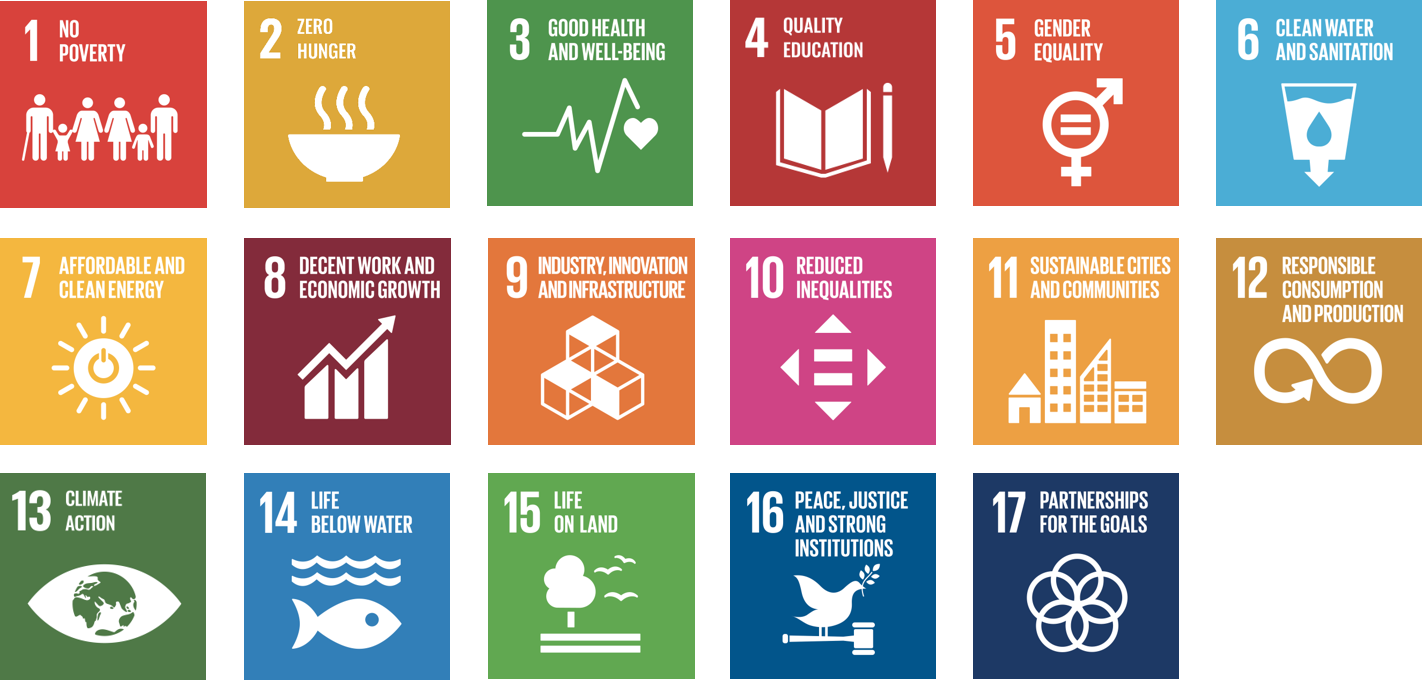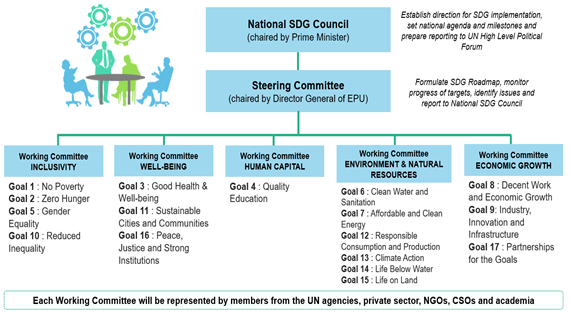Background
- Malaysia together with other 192 world leaders adopted the 2030 Agenda for Sustainable Development (2030 Agenda) at the United Nations General Assembly in New York on 25 September 2015. This is a global commitment towards a more sustainable, resilient and inclusive development, with 17 Sustainable Development Goals (SDGs) and 169 targets.
- The SDGs is a new, universal set of goals, targets, and indicators that UN member state will be expected to use to frame their agenda and political policies over the next 15 years (2016 – 2030). With its 17 Goals, 169 Targets and more than 200 Indicators that cover 5 dimensions namely People, Planet, Prosperity, Peace and Partnership, the SDGs will stimulate action over the next fifteen years in areas of critical importance for humanity and the planet.

- The 2030 Agenda has been shaped by relevant United Nations (UN) agreements and Conventions as well as the experiences and achievements gained through the Millennium Development Goals (MDGs), the global development agenda spanning the period 2000–2015. The 2030 Agenda was the result of two years of intensive public consultation and engagement with civil society and other stakeholders around the world. It transcends the MDGs to include wider economic, social and environmental objectives, and with a greater focus on peace, participation and inclusiveness.
- The 2030 Agenda for Sustainable Development serves as our collective blueprint to achieve a better and more sustainable future for all. The new Goals are unique in that they call for action by all countries (poor, rich and middle-income countries) to promote prosperity while protecting the planet. SDGs recognise that ending poverty must go hand-in-hand with strategies that build economic growth and addresses a range of social needs including education, health, social protection, and job opportunities, while tackling climate change and environmental protection. It challenges to get serious about delivering an integrated and balanced social, economic and environmental agenda.
- While the SDGs are not legally binding, governments are expected to take ownership and establish national frameworks for the achievement of the 17 Goals. Countries have the primary responsibility for follow-up and review of the progress made in implementing the Goals, which will require quality, accessible and timely data collection. Regional follow-up and review will be based on national-level analyses and contribute to follow-up and review at the global level.
- Economic Planning Unit (EPU) is the focal point for Sustainable Development (SD) and act as a coordinating agency on the initiatives related to SD including the Sustainable Development Goals (SDGs). SDGs was one of the outcome of the Rio+20, which was held in Rio de Janeiro, Brazil in 2012. The SDG was later being accepted as a global agenda for SD and known as 2030 Agenda in 2015, replacing the Millennium Development Goals (MDGs).
- In the process to embrace and implement the 17 SDGs in a systematic and measurable manner, Malaysia has put in place an enabling environment through the following initiatives:
- established a multi-stakeholder, participatory governance structure helmed by the National SDG Council chaired by the Prime Minister;
- held several national SDG symposiums and focus group sessions to promote awareness and participation of stakeholders;
- conducted studies on data readiness and gap analysis;
- undertaken a mapping exercise involving nongovernment and civil society organisations and the private sector to align SDGs with 11MP initiatives;
- formulated a National SDG Roadmap to guide implementation of the 2030 Agenda and the SDGs; and
- implementing SDG initiative under the framework of the 11MP. Moving forward, Malaysia will implement the 2030 Agenda under the framework of 11MP, whereby the means of implementation include:
- localising SDGs at sub-national levels by replicating the national multi-stakeholder governance structure at state levels;
- mobilising resources and funding through partnerships with stakeholders including crowd sourcing, social entrepreneurship and Corporate Social Responsibility programmes besides public sector funding under 11MP; and
- strengthening data readiness and filling data gaps to develop a comprehensive dataset for SDG implementation
Institutional Mechanisms for SDG Implementation
At the apex of the SDG governance structure is the National SDG Council, chaired by the Prime Minister of Malaysia. This Council plans and monitors the SDG implementation. The Council is supported by a National Steering Committee (NSC), chaired by the Director General of the EPU, as illustrated in Figure 13. The National SDG Council reports to the UN via the High-level Political Forum. The NSC consists of five SDG Cluster Working Committees (CWCs), under which are Task Forces for each of the Goals. The five CWCs and their respective SDGs are shown in Figure 14. The CWCs are tasked with identifying indicators for each SDG, as well as with developing and implementing programmes and reporting progress to the NSC. Each CWC is led by a Section Head in EPU and includes representatives of Government Ministries/agencies, civil society, the private sector, academics, United Nations agencies and youth representatives. In this regard, the central agency, EPU, has an overall view and is able to monitor implementation. Critically, the inclusive and participatory approach used in this governance structure is in line with the 11MP, which focuses on a paradigm shift towards more participatory government by citizens, including NGOs/CSOs, as partners in service design and delivery. Greater engagement of NGOs/CSOs thus is envisaged.The SDG governance structure in Malaysia is shown in Exhibit I.
Exhibit I: The SDG governance structure in Malaysia

The Alignment of SDG in Malaysia’s National Development Plan
- Malaysia recognises that a comprehensive implementation of SDGs will require the mobilisation of resources, including manpower, capacity building, and physical spaces as well as funding. Since Malaysia’s national development plan has always been geared towards economic, social and environmental agenda, the implementation of SDGs in Malaysia are aligned with the five-year national development plan, which utilises the government development budget. Thus, allocation of resources and funding are readily made available
- The alignment of SDG and national development is realised through a mapping exercise involves the integration of the national development plan’s action plans, initiatives and outcomes to the SDGs’ goals, targets and indicators. The mapping exercise begins with the Eleventh Malaysia Plan (11MP), 2016-2020, then continue with the Mid-Term Review (MTR) of 11MP, 2018-2020, and subsequently with the Twelfth Malaysia Plan (12MP), 2021-2025 and the Thirteenth Malaysia Plan (13MP), 2026-2030. The mapping of SDGs with 11th Malaysia Plan strategic thrust and six policy pillars under the MTR of 11MP is shown in Exhibit II and III.
- Shared Prosperity Vision (SPV) 2030 as announced in 2019. The 12MP, covering three development dimensions – economic empowerment, environmental sustainability and social reengineering will further crystallise the implementation of the SPV 2030. The underlying principle o SPV 2030 is economic growth through "equitability of outcome" and outlined eight enablers, seven strategic thrust with 15 guiding.
Exhibit II:Mapping of 11th Malaysia Plan and the SDG

Exhibit III: Mapping of Mid Term Review of the 11th Malaysia Plan and the SDG

Malaysia’s Voluntary National Review 2017
- In support of the global monitoring and reporting of the Agenda, Malaysia takes pride in presenting a Voluntary National Review (VNR) at the 2017 global High-level Political Forum (HLPF), and is committed to undertaking broader country reporting every four years. This document is Malaysia’s first VNR on the 2030 Agenda.
- Malaysia presented Voluntary National Review 2017 at the High-level Political Forum theme of “Eradicating poverty and promoting Malaysia’s prosperity in a changing world”. The report presenting the achievements of Malaysia on selected SDGs. Some of the achievements are as below:
- SDG 1 & 2: Absolute poverty reduced from 49.3% (1970) to 0.6% (2014) with no reported cases of hunger.
- SDG 3: Child and maternal mortality rates are almost at the level of developed countries; eradicated endemic small pox and polio and reversed the spread of HIV/AIDS. Drastic reductions in water-borne diseases, deaths from treatable childhood diseases and malaria. Government has been taking ownership of the national response towards non-communicable diseases while working strongly with non-governmental partners.
- SDG 4 & 5: More than 90% enrolment rates for primary and secondary school levels for both boys and girls and 33% for higher education with gender ratio slightly in favour of girls. Education is a tool to foster unity and national harmony, greater emphasis to inculcate good values, promote tolerance and nurture respect for fellow human beings, also for the law and the constitution.
- SDG 6: Over 95% coverage for water and sanitation, and electricity supply at national level. Which through developing mechanism to coordinate engagements and empower non-government stakeholders and communities.
- SDG 7, 12 & 16: Laws, regulations, policies and plans in place to better protect and ensure sustainable use of natural assets.
- SDG 8: Full employment since 1992, at the work place, various laws has been amended to improve work conditions, anti-discrimination and various aspects of industrial relations.
- SDG 10: Income inequalities reduced, as indicated by lower Gini Coefficient from 0.513 (1970) to 0.401 (2014). Government protect workers via a minimum wage policy, provided better labour market information and voluntary separation schemes. Policies were formulated, which include improve labour migration management including a commitment to phase out outsourcing agencies, clearer statutory responsibility of employers, a minimum wage law that covers migrant workers and bilateral MOUs with countries of origin to limit the fees charged to workers.
- SDG 13, 14, 15, &17: As of 2015, Malaysia maintained more than 50% forest cover, 10.76% as terrestrial protected areas and 1.06% as marine protected areas. Carbon intensity reduced by 33% since 2009 and renewable energy capacity increased.
Malaysia SDG Summit 2019
- In September 2019, Malaysia hosted the Malaysia SDG Summit 2019 themed on “The Whole of Nation Approach: Accelerating Progress on the SDGs” to create public awareness and understanding on SDGs as well creating a platform to discuss the progress, opportunities, challenges and solutions with various stakeholders, i.e. public and private sectors, academia, non-government organisations. The event was co-organised between Government of Malaysia and UN Malaysia and stood as a testament to Malaysia’s commitment, to bring together a broad range of stakeholders to take stock of SDG progress, gaps and explore ideas and solutions to bridge these gaps.
- With over 2,600 registered attendees across the two day Summit, numerous critical themes were discussed, from ideating on strategies to leave no one behind; ensuring that environmental sustainability is placed central in Malaysia’s development paradigm; highlighting the challenges and opportunities in unlocking the potential of women in Malaysia; to emphasizing the role of institutional reform and ensuring a whole of nation approach in order to accelerate our progress on SDG achievement.
- This platform is important in bridging the gaps and the summit was not meant to be a single event, but as a catalyst for future dialogues and collaborations across sectors, to ensure that we achieve the 2030 Agenda together.

Links:
- United Nation’s Sustainable Development Goals
- Malaysia’s SDG Monitoring System
- Malaysia’s Voluntary National Review 2017
- The Initial Assessment of the SDG Indicators for Malaysia 2018 by Department of Statistics Malaysia (DOSM)
- Malaysia SDG Summit 2019
- Sustainable Development Goals (SDG) Indicators, Malaysia 2018
- Sustainable Development Goals (SDG) Indicators, Malaysia 2019
- Sustainable Development Goals (SDG) Indicators, Malaysia 2021
- SDG Roadmap Phase I 2016-2020
- Malaysia Voluntary National Review (VNR) 2021
- 120574 views


























